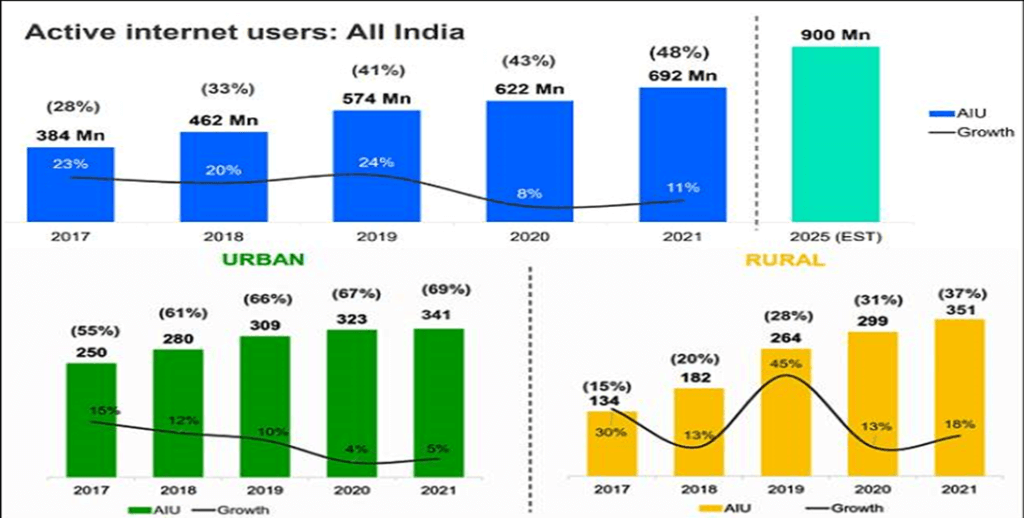The Telecom Regulatory Authority of India has recently repealed the dial-up internet connection service norms, which were issued when the dial-up service was the only service available for accessing low-speed internet. Dial-up connections use modems to decode audio signals into data to send to a router or computer. However, the telecom technologies have evolved to offer high-speed broadband service on xDSL, FTTH, and LTE.
Internet Users in India
According to the Internet in India report 2022, there are 692 million active internet users in the country, out of which 351 million are from rural areas, and 341 are from urban areas. As per the Internet and Mobile Association of India, the number of internet users in India is likely to reach 900 million by 2025. India has outnumbered the United States in the population practising digital transactions.
However, around 762 million Indians have not adopted the internet yet, including 63% from rural pockets of the country. The number of male internet users is greater than female users across rural as well as urban areas.

Govt Initiatives
- The Indian government has launched several initiatives to increase internet penetration in the country.
- The Prime Minister Wi-Fi Access Network Interface (PM-WANI) program aims to provide public Wi-Fi service through Public Data Offices (PDOs) spread across the length and breadth of the country, similar to what Public Call Offices (PCOs) did for telephone spread in India.
- The Bharat Net Project is the world’s largest rural broadband connectivity program using optical fibre to create robust middle-mile infrastructure for taking broadband connectivity to Gram Panchayats.
- The National Broadband Mission aims to facilitate universal and equitable access to broadband services across the country.
Challenges
The Indian telecom sector is facing several challenges,
- The Right of Way has been a contentious issue for the Indian telecom sector due to variable and complex legal procedures across states, non-uniformity in levies, and approvals from the Forest Department, Railways, and National Highway Authority.
- The Indian network does not have very much fixed-line coverage, while most developed countries have a high penetration of fixed lines.
- There are fewer than 25% of towers in India connected to fiber networks, compared to more than 70% in developed nations.
- Getting into semi-rural and rural areas is challenging for service providers due to the huge initial fixed costs.
Way Forward
To realise the objectives of Digital India, the creation of digital infrastructure and the development of digital skills must go hand in hand. The rural population needs to be empowered to make full use of digital opportunities. The government needs to focus on improving fixed-line coverage, and more towers need to be connected to fiber networks. The Right of Way issue needs to be resolved by uniformity in levies and approval procedures. By addressing these challenges, the Indian telecom sector can provide high-quality and affordable internet services to all Indians, regardless of their location or socio-economic status.
Why In News
Recently, the Telecom Regulatory Authority of India repealed dial-up internet connection service norms. These regulations were issued when the dial-up service was the only service available for accessing low-speed internet, and with the evolution of telecom technologies, high-speed broadband services like xDSL, FTTH, and LTE have now become more prevalent.
MCQs about Dial-Up Internet Regulations
-
Which of the following is the world’s largest rural broadband connectivity program?
A. Bharat Net Project
B. National Broadband Mission
C. PM-WANI program
D. Public Data Offices (PDOs)
-
What is the primary objective of the National Broadband Mission?
A. Increase internet penetration in India
B. Provide public Wi-Fi service through PDOs
C. Create robust middle-mile infrastructure
D. Increase fixed-line coverage in India
-
What is the major challenge faced by service providers when entering semi-rural and rural areas in India?
A. Lack of fixed-line coverage
B. Complex legal procedures
C. High initial fixed costs
D. Fewer than 25% of towers connected to fiber networks
-
Which of the following norms was recently repealed by the Telecom Regulatory Authority of India?
A. Broadband connectivity program
B. PM-WANI program
C. Dial-up internet connection service norms
D. Right of Way norms
Boost up your confidence by appearing our Weekly Current Affairs Multiple Choice Questions
![]()


